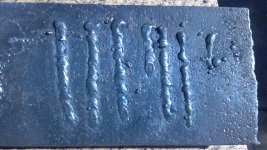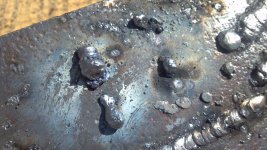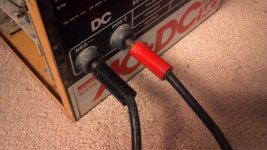Well, the fan is still not fixed, but I took the cover off the welder and aimed a box fan at it so I could get a little more practice in. I moved from the relatively shaded part of my driveway that I was working on to an in-the-sun part, and lo and behold, I could actually SEE the rod and the work piece, just a tiny bit. Made starting the arc much easier, although I still have a lot of practice to go. At least I wasn't going by feel alone, though, just stab-stab-stabbing at the piece until I got lucky. Here are some of my practice beads.

These are all AC E6011. One question that I have is what is the "crackly" black material at the edges of the bead? Is it just flux that is not getting brushed off? Or is that undercutting? Or something else?
I tried again to use DC, but no love. The rod would stick immediately no matter what I did. I even tried turning the amps all the way up on the machine. I could see that the rod was a lot hotter: the sparks it made while scratching were larger and the flares it made when I pulled it away after sticking were larger, but no arc. Finally, with the most careful of careful motions, I was able to strike a very precarious arc (at recommended amperage for the rod). The pool moved very slowly and the hot metal wanted to actually bead up and roll along the surface of the work piece. When I was done, there was very little penetration and lots of tall build-up of weld metal, some of which cracked off when I brushed off the slag. See below for two examples:

I can't for the life of me figure out what's going on here. Maybe I should spring for a box of fresh rods just to rule that out. Or is this just lack of technique? DC is supposed to be easier, but so far, I cannot even really get started with it. For the very-brief time that I actually had a DC arc going, I thought I got a sense of its benefits. The pool was steady and not spattering and jumping around. I want more of that!
BTW, I also tried both AC and DC with E7018, but with terrible results. But since those are low-hydrogen and they have not been stored in a dry location, I would chalk that up to the rods.


